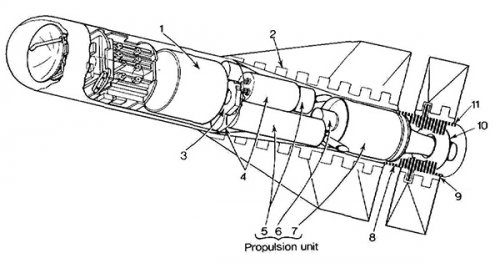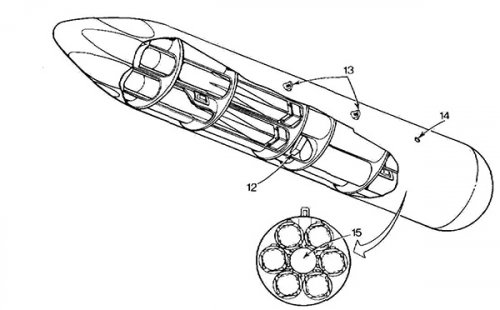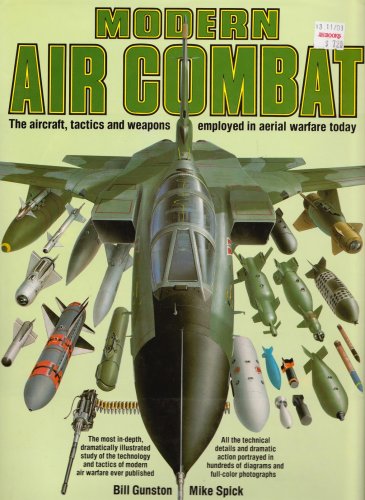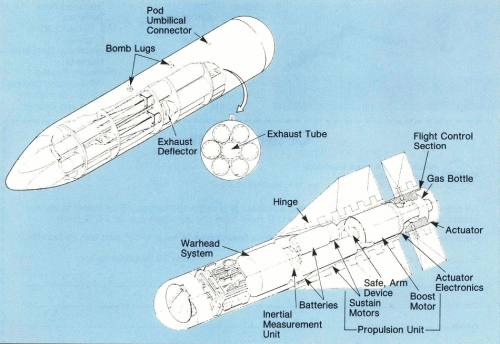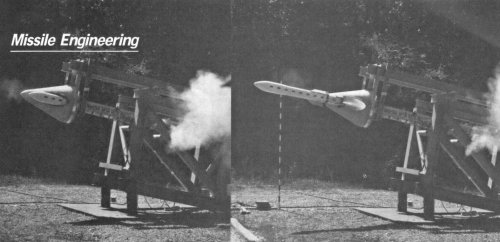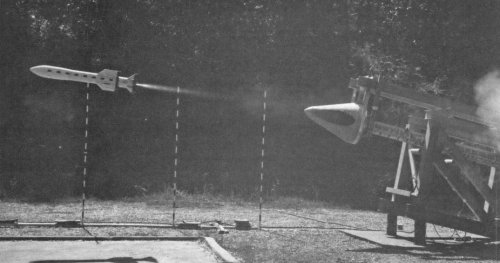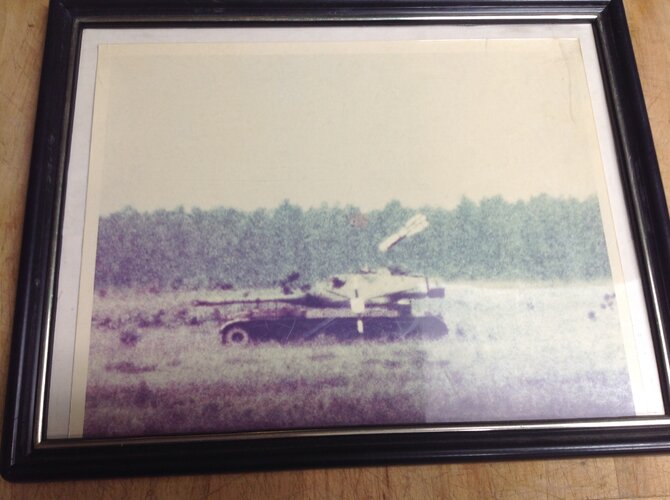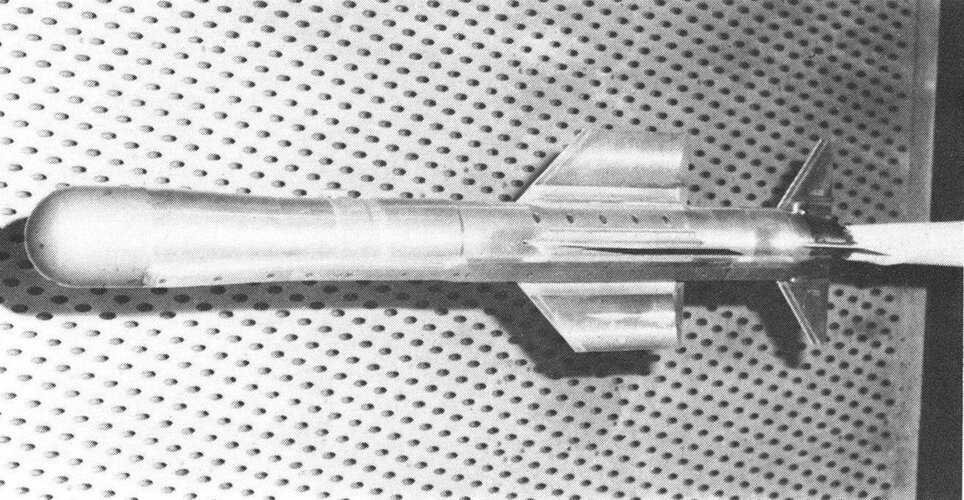- Joined
- 27 December 2005
- Messages
- 17,027
- Reaction score
- 22,262
Source:
Wasp: millimetre-wave mini-missile
The Warsaw Pact has many more tanks than Nato. But when the attack begins, not all those tanks will be available. On both sides there will be a race to reinforce the front line, to replace losses and to overwhelm weak defences. Warsaw Pact lines of communicationare all overland, while Nato must rely on long, vulnerable air and sea bridges. To attack Warsaw Pact reinforcements while they are still far from the front line requires a weapon with long range, but with surgical accuracy. Tanks move, and their armour protection requires a direct hit with a lethal warhead to ensure a kill.
There is no shortage of targets, and no possibility of confusion with friendly forces, but each weapon must be able to isolate, from other less vital targets, the tanks it has come to kill. Aircraft still offer the most flexible, effective method of attacking targets deep in enemy territory. Flying low and fast, and making full use of electronic and lethal countermeasures, an aircraft can penetrate in all weathers. But tanks, however far from the front line, are not left undefended. For an aircraft to survive in the face of heavy air defences, it must attack on the first pass, destroying the maximum number of targets before escaping without seeing, or being seen by, its target.
Under the umbrella of the Wide Area Anti-Armour Munitions programme, the US Air Force has had mixed success in its efforts to develop air-delivered weapons for use against such "second-echelon" targets. One approach, however, appears to be exceeding expectations, and that is the Wasp anti-armour mini-missile now under development by Hughes Aircraft Missile Systems Group. Wasp is a 120 lb weapon designed to be carried in large numbers by F-16s, A-10s, and F-111Fs. Fired in swarms from underwing pods, the Wasp mini-missile will autonomously search for, acquire, and attack armoured vehicles using an all-weather millimetre wave radar seeker. Launched at low level from an aircraft out of sight of its target, the missiles fly a series of preprogrammed manoeuvres until they acquire the correct target, then dive to penetrate the tank's vulnerable top armour.
Wasp mini-missiles are carried in a 12-round launch pod, which also serves as an environmentally sealed shipping and storage container. Shelf life is ten years, and the pod and the missiles it contains require no maintenance, only an external damage check before being loaded on to the aircraft.
The pod weighs 2,000 lb and fits a standard bomb-rack. An F-16 would carry two Wasp pods; an A-10 or F-111 , four. The missiles can be fired singly or in salvoes of up to 12, and the pods are jettisoned when empty. Inside the pod are six 9in diameter launch tubes. Two missiles are loaded one behind the other in each of these tubes. Rocket efflux from the forward missile is deflected towards the centre of the pod to protect the radome of the aft Wasp. Rapid sequential launch of the missiles requires that a second Wasp be fired before the first has cleared its tube. The firing sequence is therefore forward, adjacent forward, then aft, continuing round the pod. A sensor in the nose of each aft missile aborts launch should the forward Wasp remain in the tube.
The Wasp installation makes maximum use of existing cockpit facilities, including stores control panel and weapon-release switches. The only essential is an aircraft inertial platform for waypoint navigation. The pod itself contains all launch control and reporting electronics. The folding-fin missile is of traditional Hughes design, with delta wings ahead of rectangular cruciform control surfaces.
The boost motor, a variant of that developed for the Tow anti-tank weapon, burns for 1-2sec, just long enough to blast the missile clear of its launch tube. Ahead of the booster are two sustainer motors, which ignite when cruise velocity drops below a minimum value required for effective seeker search.
Wasp is 8in in diameter, with folding wings and fins. Behind the millimetre-wave seeker and its electronics is the shaped-charge
warhead 1
hinge 2
inertial measurement unit 3
batteries 4
sustainer motors 5
safe/arm device 6
and boost motor 7.
Actuates electronics 8
actuator 9
and gas bottle 10
make up the flight control section 11.
Twelve Wasps are carried in a sealed launch pod with exhaust deflector 12
for the forward missiles, standard 30in bomb-rack connections 13
umbilical 14
and central exhaust tube 15
Wasp: millimetre-wave mini-missile
The Warsaw Pact has many more tanks than Nato. But when the attack begins, not all those tanks will be available. On both sides there will be a race to reinforce the front line, to replace losses and to overwhelm weak defences. Warsaw Pact lines of communicationare all overland, while Nato must rely on long, vulnerable air and sea bridges. To attack Warsaw Pact reinforcements while they are still far from the front line requires a weapon with long range, but with surgical accuracy. Tanks move, and their armour protection requires a direct hit with a lethal warhead to ensure a kill.
There is no shortage of targets, and no possibility of confusion with friendly forces, but each weapon must be able to isolate, from other less vital targets, the tanks it has come to kill. Aircraft still offer the most flexible, effective method of attacking targets deep in enemy territory. Flying low and fast, and making full use of electronic and lethal countermeasures, an aircraft can penetrate in all weathers. But tanks, however far from the front line, are not left undefended. For an aircraft to survive in the face of heavy air defences, it must attack on the first pass, destroying the maximum number of targets before escaping without seeing, or being seen by, its target.
Under the umbrella of the Wide Area Anti-Armour Munitions programme, the US Air Force has had mixed success in its efforts to develop air-delivered weapons for use against such "second-echelon" targets. One approach, however, appears to be exceeding expectations, and that is the Wasp anti-armour mini-missile now under development by Hughes Aircraft Missile Systems Group. Wasp is a 120 lb weapon designed to be carried in large numbers by F-16s, A-10s, and F-111Fs. Fired in swarms from underwing pods, the Wasp mini-missile will autonomously search for, acquire, and attack armoured vehicles using an all-weather millimetre wave radar seeker. Launched at low level from an aircraft out of sight of its target, the missiles fly a series of preprogrammed manoeuvres until they acquire the correct target, then dive to penetrate the tank's vulnerable top armour.
Wasp mini-missiles are carried in a 12-round launch pod, which also serves as an environmentally sealed shipping and storage container. Shelf life is ten years, and the pod and the missiles it contains require no maintenance, only an external damage check before being loaded on to the aircraft.
The pod weighs 2,000 lb and fits a standard bomb-rack. An F-16 would carry two Wasp pods; an A-10 or F-111 , four. The missiles can be fired singly or in salvoes of up to 12, and the pods are jettisoned when empty. Inside the pod are six 9in diameter launch tubes. Two missiles are loaded one behind the other in each of these tubes. Rocket efflux from the forward missile is deflected towards the centre of the pod to protect the radome of the aft Wasp. Rapid sequential launch of the missiles requires that a second Wasp be fired before the first has cleared its tube. The firing sequence is therefore forward, adjacent forward, then aft, continuing round the pod. A sensor in the nose of each aft missile aborts launch should the forward Wasp remain in the tube.
The Wasp installation makes maximum use of existing cockpit facilities, including stores control panel and weapon-release switches. The only essential is an aircraft inertial platform for waypoint navigation. The pod itself contains all launch control and reporting electronics. The folding-fin missile is of traditional Hughes design, with delta wings ahead of rectangular cruciform control surfaces.
The boost motor, a variant of that developed for the Tow anti-tank weapon, burns for 1-2sec, just long enough to blast the missile clear of its launch tube. Ahead of the booster are two sustainer motors, which ignite when cruise velocity drops below a minimum value required for effective seeker search.
Wasp is 8in in diameter, with folding wings and fins. Behind the millimetre-wave seeker and its electronics is the shaped-charge
warhead 1
hinge 2
inertial measurement unit 3
batteries 4
sustainer motors 5
safe/arm device 6
and boost motor 7.
Actuates electronics 8
actuator 9
and gas bottle 10
make up the flight control section 11.
Twelve Wasps are carried in a sealed launch pod with exhaust deflector 12
for the forward missiles, standard 30in bomb-rack connections 13
umbilical 14
and central exhaust tube 15

